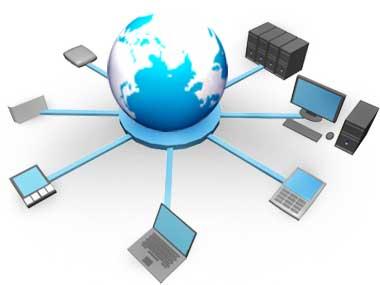Mobile Computing
Mobile Computing is a technology that allows us to transmit data, audio, and video via devices that are not connected with any physical link. The key features of mobile computing are that the computing devices are portable and connected over a network.
Mobile computing began with the first laptops developed in 1980, and from there, rapidly grew in capability with the 640*640 portable laptops from Apple in 1990, the development of the first PDA in 1993, the first smartphone from IBM released in 1994, network connectivity enabled smartphones in 2000, the first iPhone released in 2007, and the first android smartphone in 2009.
Today there is great variety among mobile computing devices, and their capabilities are increasing with each new model released.
The major elements of mobile computing are mobile communication, mobile hardware, and mobile software.
Mobile Communication: This refers to the communication infrastructure set in place, including wireless network infrastructure, protocols, data formats, bandwidths, and portals necessary to ensure seamless connectivity and communication.
Mobile Hardware: The hardware is the mobile computing devices and supporting devices, with the capabilities required to perform their required operations and connect to networks.
Mobile Software: The most important software component is the operating system, which is the brain of any computing system. For a laptop, this may be Windows, Linux or macOS, and for a smartphone, it may be Android or iOS. The different applications running on a device are also part of the mobile software.
These dramatic lifestyle changes that occurred over the years are due to advancements in a field called mobile computing. Creating portable devices that allowed network communication changed the world in quite a big way.
Today, smartphones are ubiquitous, every other house has an Alexa, and laptops are getting thinner and lighter by the day without compromising on processing power. Personal computers are losing their popularity as the limitations of mobile computing are slowly becoming overcome.
So from the early days of chunky laptops to the paper-thin screens of the present and future, mobile computing is an evolving field of great relevance.
What is Mobile Computing?
Mobile Computing is a technology that allows us to transmit data, audio, and video via devices that are not connected with any physical link. The key features of mobile computing are that the computing devices are portable and connected over a network.
Mobile computing began with the first laptops developed in 1980, and from there, rapidly grew in capability with the 640*640 portable laptops from Apple in 1990, the development of the first PDA in 1993, the first smartphone from IBM released in 1994, network connectivity enabled smartphones in 2000, the first iPhone released in 2007, and the first android smartphone in 2009.
Today there is great variety among mobile computing devices, and their capabilities are increasing with each new model released.
The major elements of mobile computing are mobile communication, mobile hardware, and mobile software.
Mobile Communication: This refers to the communication infrastructure set in place, including wireless network infrastructure, protocols, data formats, bandwidths, and portals necessary to ensure seamless connectivity and communication.
Mobile Hardware: The hardware is the mobile computing devices and supporting devices, with the capabilities required to perform their required operations and connect to networks.
Mobile Software: The most important software component is the operating system, which is the brain of any computing system. For a laptop, this may be Windows, Linux or macOS, and for a smartphone, it may be Android or iOS. The different applications running on a device are also part of the mobile software.
Mobile Computing Devices
Usually, a mobile computing device would have a body- made of metal or plastic, a RAM, a CPU, a hard drive, a motherboard, a keyboard and a mouse- which could be separate components in the body or touch-based, a screen, a video card, an operating system, software applications, and finally, a network connection
This is around the same as the components of a personal computer, which isn't a mobile device. But mobile devices may have other components too, to make them portable, and certain characteristics that make them different.
Size: The portability of mobile devices demand a smaller size. Reduction in size without reducing capabilities have also always been a challenge when developing mobile devices
Power Source: Mobile devices are usually powered by rechargeable batteries. Improving the battery life of mobile devices is another significant area of resean
Operating System: Laptops run on more or less the same OS as PCs, but for smartphones and other devices, the OS is significantly different. They are powerful but scaled-down and made specifically for particular devices.
Connectivity: Mobile computing devices have capabilities that allow access to the internet. Also, mobile devices like smartphones have access to mobile broadband networks that allow you to make and receive phone calls
Applications: Applications meant for mobile devices are specifically designed for running on a particular OS. These applications are what extends the capabilities of devices beyond just connecting to the internet or making calls.
Other features generally found in mobile computing devices include GPS capability, accelerometer, compass, microphone, camera, and so on.
Mobile computing devices have evolved greatly over time. A lot of the devices that existed in the past have been phased out, like the Personal Digital Assistant (PDA). We live now in the age of the smartphone, but there are several other categories of mobile computing devices -
Laptop: Laptop computers are portable personal computers. It is meant to offer the same functionality as a PC, so the same OS, applications, and files can run on this
Smartphone: A smartphone is a mobile phone with powerful capabilities. They typically have a touchscreen interface, have internet access, can run various applications, and include features like a camera and GPS.
Tablet computer: Tablets have touchscreens and virtual keyboards, and are often thought of as an intermediary between a laptop and a smartphone. They have better processing power, functionality, and screen resolution than smartphones. Some models may also have a stylus meant for navigating the touch screen better
Wearable: A more recent addition, wearable computers like smartwatches offer limited features similar to a smartphone within a watch.
E-reader: E-readers are devices that are similar to tablets, but their main purpose is to read digital documents.
Other devices include scanners, carputers, handheld gaming consoles, advanced digital cameras, smart speakers, and so on.

 SkillClick
SkillClick
